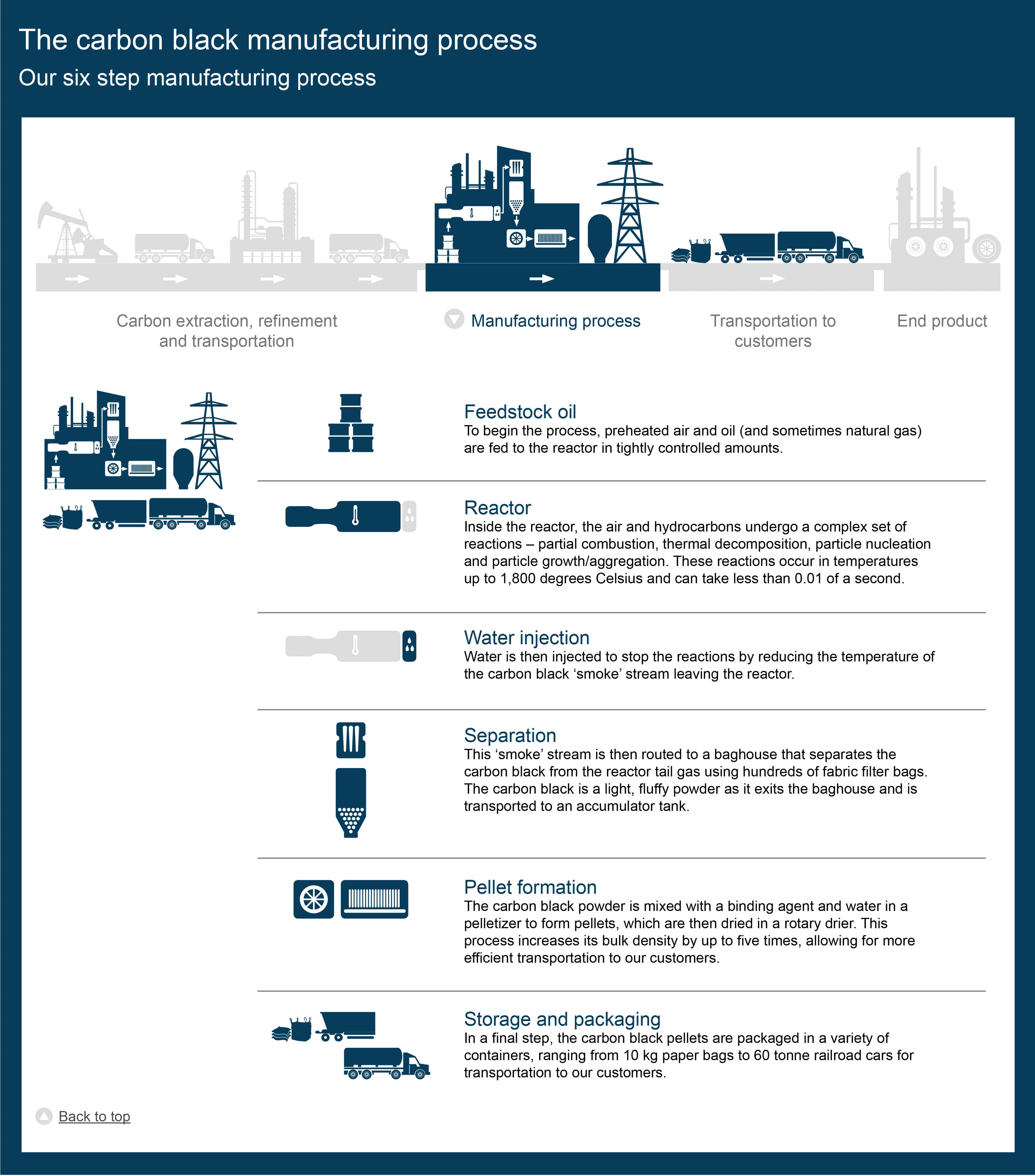CARBON BLACK 101
Time to read: 4 minutes
A carbon black’s application performance is determined by its fundamental properties and the level of dispersion achieved. The most important physical and chemical properties include particle size, porosity, structure, and surface chemistry. These properties are distributional in nature, and this distribution in properties affects performance. The level of dispersion in any given matrix is strongly influenced by the mixing equipment, formulation (including dispersant selection), and physical form.
What is carbon black? A vital component in making many of the products we use every day stronger, deeper in color and longer lasting, carbon black in its pure form is a fine black powder, essentially composed of elemental carbon. It is produced by partial burning and pyrolysis of low-value oil residues at high temperatures under controlled process conditions.
Carbon black is mainly used to strengthen rubber in tires, but can also act as a pigment, UV stabilizer, and conductive or insulating agent in a variety of rubber, plastic, ink and coating applications. Apart from tires, other everyday uses of carbon black include hoses, conveyor belts, plastics, printing inks and automotive coatings.
The fundamental properties of carbon black determine application performance. These include:
- Particle Size
- Structure
- Porosity
- Surface Chemistry or Surface Activity
- Physical Form
PARTICLE SIZE
Measured by electron microscopy, this is the fundamental property that has a significant effect on rubber properties, as well as color properties for specialty carbon blacks.
For specialty carbon blacks, smaller particle diameter gives rise to higher surface area and tinting strength. High surface area is usually associated with greater jetness, higher conductivity, improved weatherability, and higher viscosity, but requires increased dispersion energy.
For rubber, finer particles lead to increased reinforcement, increased abrasion resistance, and improved tensile strength. To disperse finer particles size, however, requires increased mixing time and energy. Typical particle sizes range from around 8 nanometers to 100 nanometers for furnace blacks. Surface area is utilized in the industry as an indicator of the fineness level of the carbon black and, therefore, of the particle size.
STRUCTURE
This is a measure of the three-dimensional fusion of carbon black particles to form aggregates, which may contain a large number of particles. The shape and degree of branching of the aggregates is referred to as structure.
Highly structured carbon blacks provide higher viscosity, greater electrical conductivity and easier dispersion for specialty carbon blacks. Measures of aggregate structure may be obtained from shape distributions from EM analysis, oil absorption (OAN) or void volume analysis.
The structure level of a carbon black ultimately determines its effects on several important in-rubber properties. Increasing carbon black structure increases modulus, hardness, electrical conductivity, and improves dispersibility of carbon black, but increases compound viscosity.
POROSITY
This is a fundamental property of carbon black that can be controlled during the production process. It can affect the measurement of surface area providing a total surface area (NSA) larger than the external value (STSA).
Conductive specialty carbon blacks tend to have a high degree of porosity, while an increase in porosity also allows a rubber compounder to increase carbon black loading while maintaining compound specific gravity. This leads to an increase in compound modulus and electrical conductivity for a fixed loading.
SURFACE CHEMISTRY OR SURFACE ACTIVITY
This is a function of the manufacturing process and the heat history of a carbon black and generally refers to the oxygen-containing groups present on a carbon black’s surface.
For specialty carbon blacks, oxidized surfaces improve pigment wetting, dispersion, rheology, and overall performance in selected systems. In other cases, oxidation increases electrical resistivity and makes carbon blacks more hydrophilic. The extent of surface oxidation is measured by determining the quantity of the “volatile” component on the carbon black. High volatile levels are associated with low pH.
While difficult to measure directly for rubber, surface chemistry manifests itself through its effects on such in-rubber properties as abrasion resistance, tensile strength, hysteresis, and modulus. The effect of surface activity on cure characteristics will depend strongly on the cure system in use.
PHYSICAL FORM
This is important in matching a carbon black to the equipment by which it is to be dispersed. The physical form (beads or powder) can affect the handling and mixing characteristics.
The ultimate degree of dispersion is also a function of the mixing procedures and equipment used. Powdered carbon blacks are recommended in low-shear dispersers and on three-roll mills. Beaded carbon blacks are recommended for shot mills, ball mills, and other high energy equipment. Beading provides lower dusting, bulk handling capabilities, and higher bulk densities, while powdered carbon blacks offer improved dispersibility.
HOW IS CARBON BLACK MADE?
At Birla Carbon, we produce carbon black in a high temperature reactor through a tightly controlled flame-synthesis process that uses oil, and sometimes natural gas, as feedstock. The oil is usually a residue derived from crude oils or coal and is purchased from refineries, petrochemical plants and coal tar distillers.
By making adjustments to the reactor conditions – such as temperature, flow rates, reaction time and reactor design – we are able to produce a wide variety of carbon black grades with different morphology (specific surface area and structure level) to meet the diverse needs of all of our customers. Throughout the manufacturing process, we use distributive control systems to ensure our products meet the highest quality standards.
The six-step carbon black manufacturing process produces large quantities of hot reactor tail gas with a heating value that can be utilized to make steam and electricity. We recover as much as possible of this tail gas energy for our own internal energy needs, but we also supply our energy surplus to businesses and homes around our sites. This greatly reduces our net greenhouse gas emissions and provides a valuable resource to our neighboring communities and partners.
Our 6-Step Carbon Black Manufacturing Process
[click image to enlarge]
NEWS
ARTICLES
Powder Coatings: Trend towards higher-end applications
Developments will be driven by the need to reduce energy demand, costs, and the carbon footprint.
Birla Carbon plants in Brazil, Hungary and Egypt secure ISCC Plus Certifications
Birla Carbon, a manufacturer and supplier of carbon-based solutions announces that four more of its plants – Cubatão and Camaçari in Brazil, Tiszaújváros in Hungary, and Alexandria in Egypt, have secured the ISCC PLUS certification.
John Loudermilk’s interview with Newsweek
Birla Carbon is one of the flagship businesses of the Indian conglomerate, Aditya Birla Group. Can you provide an overview of how you fit into the broader $639 billion chemicals industry?










